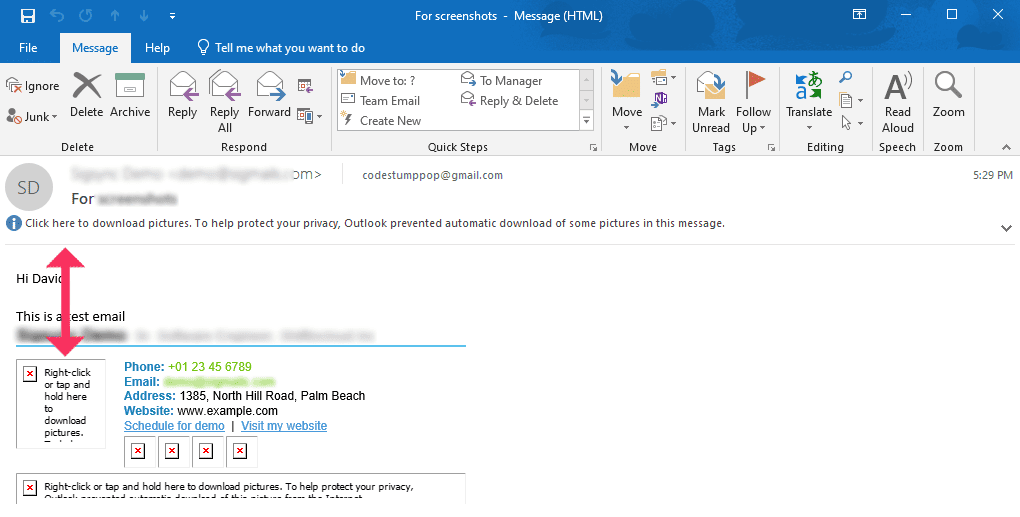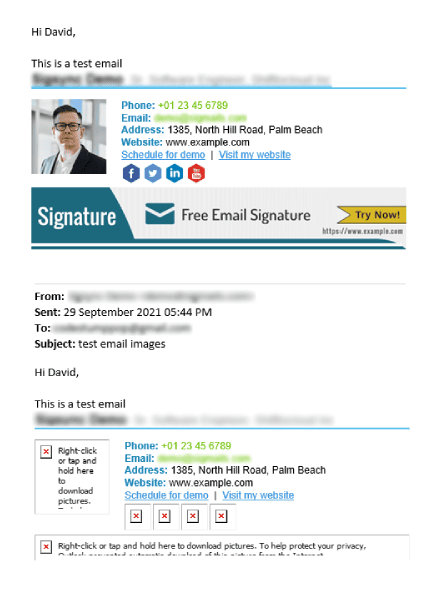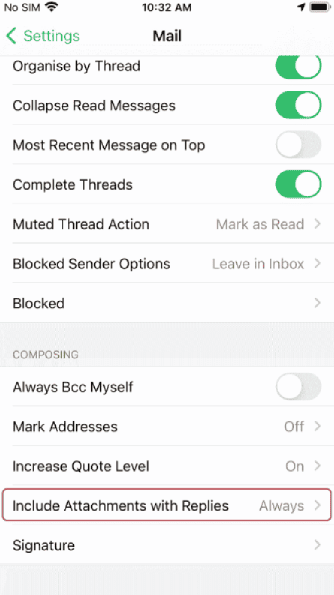How to troubleshoot image issues in Email Signatures
You may encounter issues with images in email signatures such as images not displaying in reply or forward messages, misplaced image position, and so on.
Resolution:
Embedded images are preferred over linked or hosted images because they are included directly as hidden attachments within the email signature. In contrast, hosted images are referenced via a web URL, which can cause them not to display if the link is broken or blocked. However, even embedded images may not always display correctly. In some cases, images disappear from the email conversation due to incorrect email format conversion, which can remove or misplace the images.
Let's look at some of the image-related issues in email signatures and how to fix them.
- Images not displaying in emails with Sigsync Signature.
Some users prefer web-hosted images in their email signatures because the images are stored online. However, this approach has a few drawbacks:
- Images may fail to load if the recipient has a slow internet connection.
- Certain email clients restrict downloading external images for security reasons.
The recommended approach is to use embedded images in the email signature. Embedded images are included directly as hidden attachments and reference the source of the message using a unique Content ID, ensuring that the images are reliably displayed across most email clients.
- The image disappears in reply or forward messages
Depending upon which email client you use, the message format configuration for a reply or a forward message differs from the original format, such as images added as attachments, error messages displayed instead of images or placeholders, and so on.
If you are using an Exchange environment, we recommend that you change the message configuration for reply / forward messages or force HTML email format on the message.
Image issues based on the message format
- When composing an email, the default message format is used, which can be Plain, HTML, or RTF Text depending on the email client. If any formatting or images are added, the email clients convert the message format to HTML or RTF.
The default email format on Mac devices is plain text, whereas Sigsync only supports HTML. As a result, these users must change the setting to HTML text format.
- When the signature is included with the image, then a message needs to switch to HTML or RTF format. As Sigsync supports only HTML message format, you need to force the HTML format. Visit this page for detailed steps to know how to force HTML message format for your emails.
- During lengthy email conversations, the quality of signatures with embedded images is reduced or the images are removed with an X as shown, and error messages are displayed. There is no perfect solution to these problems because there are different email clients in the market that follow different rules in terms of device compatibility.
You can try disabling the email signature in Reply / forward messages.
Image related issues based on devices or web-based email clients
- Images replaced as their filename in iOS devices: In Apple mail, by default, images are replaced with their filenames along with angle brackets for example: <images.jpg> or <sample.png>. This replacement is not only for images but for all the attachments with email though its inline or standard attachments.
Try one of the below methods to solve this problem
- The best approach is to use other mail applications like Outlook for iOS as they are designed for Office 365 and Exchange organization both on mobile as well as on desktop.
- Use remote images in the signature as they are stored in web servers and are not considered as attachments. The images are not included in the messages and are instead displayed as download links to the recipients.
- Emails are sometimes converted to Plain text format on Apple devices because it is the default email format, and as a result, images are removed due to this conversion. Signatures with images, on the other hand, are only supported in HTML signatures. If you want to insert images in the signature, consider changing the email setting to HTML text.
- Outlook was designed primarily for the Windows platform, where the embedded image filenames change with each email reply or forward. However, on Outlook for Mac, the same image filename is used for all replies/forwards. If multiple embedded images with the same filename are used, the attachment field will display all of the embedded images with the same filename.
- Images are not properly displayed in iOS 7 and later versions; instead, a Tap to Download button is added, but nothing happens when you click on it. To resolve this issue, simply close and reopen the application.
- If you have an iPhone with iOS 13 or later, go to Settings → General → Mail → Include Attachments with Replies.
- Sometimes embedded images load slowly on mobile devices. This is due to problems related to the mobile applications and not related to Sigsync service.
- Try to close and reopen the application.
- Reinstall the application on your mobile.
- If the above steps doesn't work then try to Reset the account in Microsoft Outlook else contact Microsoft Support to troubleshoot the issue.
Image-related issues as a result of the image itself
Incorrect filename: If an image is not displayed properly, try checking the image format and if required, try to replace it with the best image format i.e. JPG or PNG as they are supported by all email clients.
Use letters and numbers in the image file name and avoid using special characters like #, @,$ etc. Also avoid using image names with generic file names such as image1. Outlook appends a unique id to each embedded image filename, but using a generic image name may result in duplicate images that are displayed incorrectly.
Wrong scaling of images: Image scaling issues occur in a few environments when using higher DPI settings. You can avoid this by using image files with fixed dimensions.
Images are not displayed properly in dark mode: Profile images are directly imported from AD fields as ${profilePhoto} and these images are not displayed correctly in the dark mode. This is due to the fact that the images are stored in JPG format even though you upload images in PNG format, which does not support transparency. The images are not altered based on whether they have a light or dark background setting.
The solution to this issue is to upload the PNG image manually using Add photos with transparent background to your signature.
Streamline Email Signature Management with a Free On-demand Demo from Sigsync
Sigsync email signature service provides effortless, centralized signature management for Office 365 and Exchange. Our team can assist you in quickly setting up company-wide signatures. Request a free on-demand demo to see how Sigsync can simplify your email signature management process.




